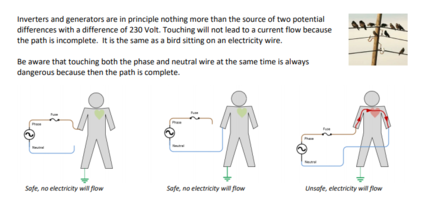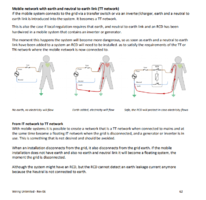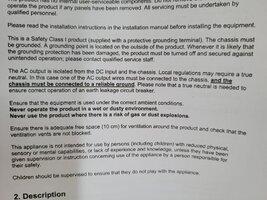Can anybody explain why my inverter (Victron Pheonix 12/250) has an earth? Presumably I can just wire it along with my -ve DC connection to an earthing point on the chassis?
You are using an out of date browser. It may not display this or other websites correctly.
You should upgrade or use an alternative browser.
You should upgrade or use an alternative browser.
Earthing inverters
- Thread starter VinylArchie
- Start date
A very good question . . . . and one im still looking for a definitive answer for. . . . it depends on your setup and if you have an incoming 240v supply or just an inverter only.
have a look at this . . .
if you have EHU installed then it needs bonding . . . if just a floating inverter it may be safer with no GND bonding.
.

.

.
**************************************************
Dellmassive`s -- "how I Done It" -- Thread
**************************************************
Kit List And Stuff -- How I Done It & What I Use --
**************************************************
VIP Membership | VW T6 Forum - The Dedicated VW Transporter T6 Forum
************************************************
For Sale - Summer-weekend-t6f Limited Edition External Stickers
For Sale - T6F Flags
**************************************************
have a look at this . . .
if you have EHU installed then it needs bonding . . . if just a floating inverter it may be safer with no GND bonding.
.

.

.
**************************************************
Dellmassive`s -- "how I Done It" -- Thread
**************************************************
Kit List And Stuff -- How I Done It & What I Use --
**************************************************
VIP Membership | VW T6 Forum - The Dedicated VW Transporter T6 Forum
************************************************
For Sale - Summer-weekend-t6f Limited Edition External Stickers
For Sale - T6F Flags
**************************************************
I have real reservations about the information contained in those diagrams. Seriously they think you can touch a 230V live wire with a path to earth (ground) through your body and think you will not get a shock.
I should add that you should check the specific inverter has an isolated output; i.e. The 240V supply has no reference to the 12V input. The 12V input is most likely referenced to the chassis of the vehicle. The 240V output must not have any reference to this to be truly isolated and "floating".
This is exactly how a shaving socket in a bathroom works.Isolation transformers used in electronics service operations work in exactly the same way. They remove the reference to ground/earth so an electrical shock circuit cannot be completed by just touching one conductor.
Ok, so I'm trying to figure this out too. I have an elecric hook up and currently wiring in a victron 12 375 inverter.A very good question . . . . and one im still looking for a definitive answer for. . . . it depends on your setup and if you have an incoming 240v supply or just an inverter only.
have a look at this . . .
if you have EHU installed then it needs bonding . . . if just a floating inverter it may be safer with no GND bonding.
.
View attachment 116611
.
View attachment 116607
.
**************************************************
Dellmassive`s -- "how I Done It" -- Thread
**************************************************
Kit List And Stuff -- How I Done It & What I Use --
**************************************************
VIP Membership | VW T6 Forum - The Dedicated VW Transporter T6 Forum
************************************************
For Sale - Summer-weekend-t6f Limited Edition External Stickers
For Sale - T6F Flags
**************************************************
Bonding the inverter is therefore recommended?
And presumably an RCD on the inverter output is also a good idea?
Not sure why you would. You will introduce an earth reference as discussed above.Bonding the inverter is therefore recommended?
An RCD will NOT work unless an output does have some form of reference (bonding) to earth.And presumably an RCD on the inverter output is also a good idea?
Personally I would be inclined to leave the inverter output isolated so it cannot proved any potential difference relative to ground. This of course assumes the inverter output is isolated to it's 12V input supply as the 0V supply from the van will have a ground/chassis reference.
Don’t earth/bond invertors for the aforementioned reasons. Treat the EHU as you would an extension lead from your house - no consumer unit needed just an inline RCD.
You don’t think anything of hoovering out your van with the vac plugged in the house!
Also how many bare metal parts do you have in your van? Probably just the sink and that’s insulated from the supply (unless you’ve bonded it
You don’t think anything of hoovering out your van with the vac plugged in the house!
Also how many bare metal parts do you have in your van? Probably just the sink and that’s insulated from the supply (unless you’ve bonded it
Ah, OK, I may have misinterpreted the post I originally quoted. I thought this was saying bond the inverter if you have an EHU installed, maybe it was simply saying an EHU itself requires earth bonding.
Have attached a photo from the inverter instructions which confirm the 240v output and inverter chassis is isolated from the 12V input. It does however say to ground the chassis - what would that achieve if the output is isolated from input and chassis?
I still don't have this 100 percent clear in my mind but leaving the (isolated/floating) inverter output unbonded does make sense. The instructions to earth the chassis is confusing me a little as to why. Though if the chassis is isolated from the output then bonding it wouldn't make any difference in terms of ensuring the 240V output remains floating......

Have attached a photo from the inverter instructions which confirm the 240v output and inverter chassis is isolated from the 12V input. It does however say to ground the chassis - what would that achieve if the output is isolated from input and chassis?
I still don't have this 100 percent clear in my mind but leaving the (isolated/floating) inverter output unbonded does make sense. The instructions to earth the chassis is confusing me a little as to why. Though if the chassis is isolated from the output then bonding it wouldn't make any difference in terms of ensuring the 240V output remains floating......

This my understanding:
Grounding/Earthing (to the vehicle chassis)of the dc side is necessary as reference but as is says later don’t earth the AC unless you have a reliable earth to your chassis which would involve an earth rod or similar.
Is there a circuit diagram?
Grounding/Earthing (to the vehicle chassis)of the dc side is necessary as reference but as is says later don’t earth the AC unless you have a reliable earth to your chassis which would involve an earth rod or similar.
Is there a circuit diagram?
A very challenging situation in case things (more than one) go wrong.It does however say to ground the chassis - what would that achieve if the output is isolated from input and chassis?
E.g. having isolated output and then
Chafed/snapped live wire touching (or through moisture) van's chassis.
and
Chafed/snapped power feed where neutral wire connects (or through moisture) to earth/ground wire of an appliance having metallic case.
Bonding ALL metallic/conductives together is a simple and effective safety measure - in case of failure elsewhere no hazardous potential differences can't spring up.
To Bond or not to Bond
Following on from the Mythbusters article in Issue 73 (November 2018) of Wiring Matters, this article looks at the recent change of the wording in Regulation 411.3.1.2 of BS 7671:2018, and what can be done to determine if a conductive part meets the requirements of an extraneous-conductive-part...
But (if we’re only talking of an inverter) and your just plugging in your hairdryer for a few minutes and the hairdryer is in good condition then the risk is very low!
It’s confusing sometimes and others will have differing opinions, I know. Sat looking around my van I’ve got very few exposed uninsulated metallic parts and the only one I can touch easily is the sink/hob which is not extraneous (in my case) so not bonded.
My chassis is earthed to EHU with an inline RCD.
I’m open to criticism! (Not about my dress sense though)
I always wondered about this subject and whether or not to connect the earth terminal on my Giandel Inverter to the vehicle chassis. They recommend connecting the earthing terminal to the vehicle chassis. I opened the inverter and saw that the earth pin on the 240.ac outlets are connected to the inverter chassis. I also emailed Giandel support. They said that inverter has its own built in protection so if a short circuit occurs the inverter internal fuses will blow.
On the giandel.com / user manual link, I extracted the text below. See below in bold italics
1) Grounding The power inverter has a terminal on the rear panel marked " Grounding "or " ". This is used to connect the chassis of the power inverter to the ground. The ground terminal has already connected to the ground wire of AC output receptacle through the internal connecting wire. The ground terminal must be connected to the ground wire, which will vary depending on where the power inverter is installed. In a vehicle, connect the ground terminal to the chassis of the vehicle. In a boat, connect it to the boat's grounding systems. In a fixed location, connect the ground terminal to earth.
On the giandel.com / user manual link, I extracted the text below. See below in bold italics
1) Grounding The power inverter has a terminal on the rear panel marked " Grounding "or " ". This is used to connect the chassis of the power inverter to the ground. The ground terminal has already connected to the ground wire of AC output receptacle through the internal connecting wire. The ground terminal must be connected to the ground wire, which will vary depending on where the power inverter is installed. In a vehicle, connect the ground terminal to the chassis of the vehicle. In a boat, connect it to the boat's grounding systems. In a fixed location, connect the ground terminal to earth.
Last edited:
Similar threads
- Replies
- 1
- Views
- 260
- Replies
- 9
- Views
- 1K
- Replies
- 21
- Views
- 2K
- Replies
- 0
- Views
- 232
- Replies
- 20
- Views
- 1K
